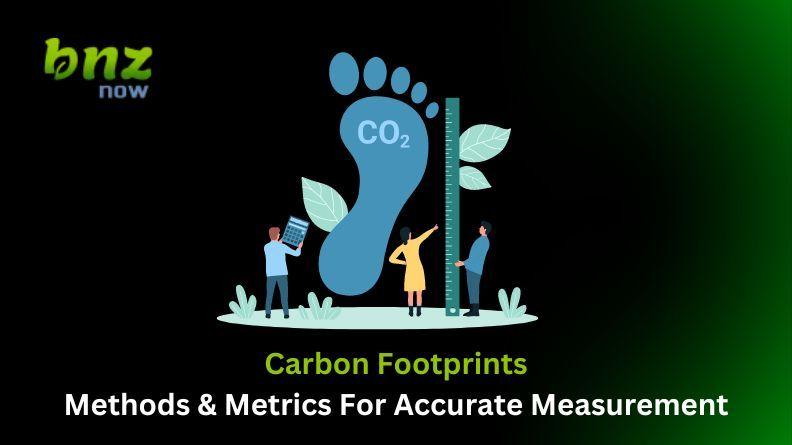Understanding Carbon Footprints: Methods and Metrics for Accurate Measurement

Carbon Footprint & Its Accurate Measurement
What is a Carbon Footprint?
A carbon footprint refers to the total greenhouse gas (GHG) emissions generated by your activities. It considers not just the direct emissions from your operations (e.g., burning fuel), but also indirect emissions throughout your value chain (e.g., business travel, purchased materials).
Importance of Accurate Measurement
Measuring your carbon footprint accurately offers a clear picture of your environmental impact. This empowers you to:
Identify areas for improvement: Pinpoint activities contributing the most emissions and prioritize reduction efforts.
Engage stakeholders: Showcase environmental commitment and transparency to customers, investors, and regulators.
Meet compliance requirements: Prepare for potential regulations mandating carbon footprint reporting.
Components of a Carbon Footprint:
The Greenhouse Gas Protocol (GHG Protocol) categorizes emissions into three scopes:
Scope 1: Direct emissions from owned or controlled sources (e.g., fuel combustion in vehicles, on-site manufacturing processes).
Scope 2: Indirect emissions from purchased electricity, heat, or steam.
Scope 3: All other indirect emissions across your value chain, including purchased goods and services, business travel, employee commuting, and waste disposal.
Methods of Measurement
Overview of Measurement Approaches:
There are two main approaches to measuring your carbon footprint:
Top-down approach: Uses financial and activity data to estimate emissions based on industry averages.
Bottom-up approach: Collects detailed data on specific activities within your organization to calculate a more precise footprint.
Step-by-Step Guide to Measuring a Company's Carbon Footprint:
Gathering Data:
Energy bills (electricity, gas)
Fuel consumption (vehicles)
Business travel details (flights, mileage)
Waste generation data
Supplier information (materials, production processes)
Calculating Emissions:
Utilize conversion factors that convert activity data (e.g., liters of fuel) into CO2 equivalent (CO2e).
Identifying Emission Sources:
Analyze results to understand which activities contribute most to your footprint.
Assessing Scope 3 Emissions:
While Scope 3 is the most challenging, consider available data from suppliers or industry benchmarks.
Tools and Resources for Measurement:
Carbon Footprint Calculators: Online tools offer a user-friendly way to estimate your footprint based on basic data inputs.
Software Solutions: Comprehensive software can manage data collection, automate calculations, and provide detailed reports.
Consulting Services: Sustainability consultants can guide you through the measurement process and offer expertise.

Metrics for Accurate Measurement
Carbon Intensity vs. Absolute Emissions:
Absolute Emissions: Total amount of GHGs emitted.
Carbon Intensity: Emissions normalized by a unit of output (e.g., CO2e per product unit produced). Both metrics are valuable, but carbon intensity helps track emission trends relative to business growth.
Reporting Standards and Guidelines:
GHG Protocol: The international standard for GHG accounting, providing a framework for consistent and transparent reporting.
ISO 14064: International standard for measuring and verifying greenhouse gas emissions.
CDP (formerly Carbon Disclosure Project): Global platform for companies to disclose environmental data, including carbon footprint.
Challenges and Limitations
Data Accuracy and Availability:
Obtaining accurate data, especially for Scope 3 emissions, can be challenging. Utilize estimations and industry benchmarks where necessary.
Scope 3 Emissions Assessment:
Scope 3 complexity requires collaboration with suppliers and potentially estimating based on industry averages.
Interpreting and Comparing Results:
Consider industry benchmarks and context when interpreting your footprint. Comparing results year-over-year provides a clearer picture of progress.
Importance of Accurate Measurement
Identifying Hotspots and Reduction Opportunities:
Accurate measurement reveals areas with the most significant emissions, allowing you to target reduction efforts strategically.
Stakeholder Engagement and Transparency:
Precise data builds trust and strengthens your sustainability claims when communicating with stakeholders.
Compliance and Regulatory Requirements:
Carbon footprint measurement prepares you for potential future regulations mandating emissions reporting.
Conclusion
Understanding and accurately measuring your carbon footprint is a crucial first step towards a sustainable future. By identifying your environmental impact, you unlock the potential to reduce emissions, engage stakeholders, and navigate the evolving regulatory landscape.
BNZ Green's Commitment to Sustainability:
BNZ Green empowers businesses to take action with its innovative Calc tool. Calc simplifies carbon footprint measurement by providing a user-friendly platform for data input and emission calculation. It guides you through the process, aligns with leading standards (GHG Protocol), and generates insightful reports to help you understand your impact.
Carbon Offsetting for a Balanced Approach:
While reducing emissions is the ultimate goal, carbon offsetting can compensate for unavoidable emissions. BNZ Green connects you with high-quality carbon offset projects that support renewable energy, forestry initiatives, and other verified emission reduction activities. These projects generate carbon credits, which represent a reduction of greenhouse gases in the atmosphere. By combining accurate measurement with strategic reduction and offsetting, you can achieve a truly sustainable business model.
Take control of your environmental impact. Start your BNZ Green Calc journey today! Let's work together to build a greener tomorrow.
